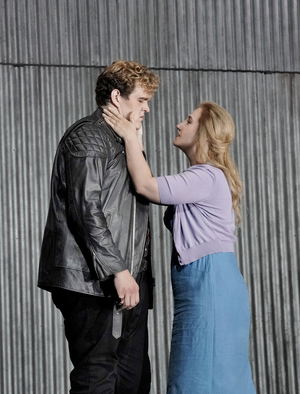Review: JENUFA at Santa Fe Opera
 On Wednesday, July 24, 2019, Santa Fe Opera presented Leoš Janáček's powerful dramatic opera Jenůfa. Laura Wilde, a former Santa Fe Apprentice who performed the title role at English National Opera in 2016, again sang the lead while Patricia Racette, who has often sung Jenůfa, portrayed her stepmother, Kostelnička. Both artists gave glorious dramatic interpretations of their roles in this shattering but moving opera.
On Wednesday, July 24, 2019, Santa Fe Opera presented Leoš Janáček's powerful dramatic opera Jenůfa. Laura Wilde, a former Santa Fe Apprentice who performed the title role at English National Opera in 2016, again sang the lead while Patricia Racette, who has often sung Jenůfa, portrayed her stepmother, Kostelnička. Both artists gave glorious dramatic interpretations of their roles in this shattering but moving opera.
Director David Alden updated the staging from 19th-century Moravia to the 1950s in Czechoslovakia. When staged at ENO in 2007, his version won the Laurence Olivier Award for Best New Opera Production.
Writing both libretto and music, Janáček (1854-1928) based the story of his 1904 opera on a play by feminist writer Gabriela Preissová (1862-1946). The opera tells of the teen-aged Jenůfa who falls in love and gets pregnant by Števa, a rich playboy who finds various reasons why he cannot marry her. When Števa's half brother, Laca, slashes her cheek in a jealous rage, she is considered disfigured. Jenůfa's stepmother, Kostelnička tries to get first Števa and then Laca to marry the girl who gives birth secretly to a son. When she finds that Laca would marry Jenůfa if she did not have the baby, despite her religious nature, Kostelnička drowns the child. It's body is discovered during Laca and Jenůfa's wedding. There, townspeople accuse the bride of the murder, but the stepmother admits guilt and the young couple go off to a new life.
Janáček's operas are emotionally powerful, relatively accessible, and true to Czech culture with their colorful orchestrations and distinctive rhythms. Alden's staging is realistic to the core. In Act I, Jenůfa was worried about Števa leaving her to go in the army. When he found he would not have to serve, he celebrated by getting disgustingly drunk. When she cuddled him, he thrust her aside. He preferred the mayor's daughter. Alden drew excellent stagecraft from his singers and the result was unusually fine dramatic performances from all.
Charles Edwards' scenic designs emphasized the poverty and lack of resources available to the inhabitants of the Czech town. The Santa Fe thunderstorm that produced copious lightening at the edges of the theater added to the sinister ambience. In the second act, the sameness of the walls, blankness of the ceiling, and the starkness of Duane Schuler's lighting emphasized the drabness of the lives of the women in Kostelnička's house. Jon Morrell's costume design, however, added some eye candy. In Act I, everyone came from work in shades of brown and gray, but in the last act, at the wedding, most members of the cast were in colorful outfits.
As the erring Jenůfa, Wilde created the picture of a girl who would always find something to worry about, but she sang with untiring and fearless silver-tinged dramatic tones. Moving from the lead to the heavier role, Racette showed the many colors of her middle range in golden trumpet sounds interspersed at quiet moments that had the velvet textures of a viola.
The delightful Susanne Mentzer was Grandmother Buryjovka, the retired mill owner who occasionally hit the offending not-so-gentle man with her purse. Vocally outstanding in the Mill Scene was former apprentice Will Liverman, the Foreman. Liverman will be Papageno at the Met this season. Apprentice soprano Jana McIntyre, who sang the Shepherd Boy, also appeared to have the ability to do larger parts.
Australian tenor Alexander Lewis and American tenor Richard Trey Smagur portrayed the two men in Jenůfa's life, Laca and Števa. As the impetuous Laca, Lewis sang with steely, bronze-edged tones. Smagur, a former apprentice, was a huge man whose large, well-rounded sound matched his size. Both gave impressive renditions of their roles.
Apprentice Sylvia D'Eramo was a dutiful Servant Girl at the Mill. Apprentice Alan Higgs was an officious Mayer while his wife and daughter, fellow Apprentices Kathleen Reveille and Katherine Beck, let it be known that they had lowered themselves to attend Jenůfa's wedding. I loved the moment when the Wife wiped her glass with her handkerchief before drinking from it.
German conductor Johannes Debus, Music Director of the Canadian Opera Company, made his Santa Fe Opera debut with this production. He presented Janáček's score in its pristine state that showed all its rough glory. Although it comes from Central Europe, Jenůfa is a story for a place like the New Mexico desert where life is strong and hard. Debus brought out the composer's use of folk material and his rendition helped make this opera more accessible to people who are unfamiliar with it. Both musically and dramatically, Jenůfa is one of the company's best shows. You can see it on August 2, 6, or 15.
Photo: Ken Howard for Santa Fe Opera
Reader Reviews

Videos
